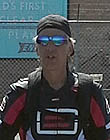|
|
This topic comprises 2 pages: 1 2
|
|
Author
|
Topic: Public Utilities Incompetitance In AZ
|
|
|
|
|
|
|
|
|
Stephen Furley
Film God

Posts: 3059
From: Coulsdon, Croydon, England
Registered: May 2002
|
 posted 07-25-2004 04:19 PM
posted 07-25-2004 04:19 PM




Steve wrote:
quote: Steve Kraus
A 200 ton load should have been moved by rail, not highway.
Funny you should say that Steve; Hixon level crossing comes to mind. A transformer was being transported by road in Britain in 1968, when it was hit by a passenger train at the crossing, resulting in many casualties. I can't remember the findings of the inquiry into the accident. Had the transformer been on a train, and it had hit a road coach full of passengers on the crossing, I doubt if the casualties would have been any less. I also doubt if, in this country, the transformer could have been transported by rail; our loading gauge is rather restricted, and abnormal loads usually have to go by road.
I have to say that our railways are very different to yours, over there you seem to transport a fair amount of freight by rail, here the railways are largely a passenger operation. Very few sources or destinations of freight have rail sidings, so road transport is needed at each end, and with most trips being only a few tens to a few hundreds of km, rail freight is largely a thing of the past.
A few large loads are moved by water, but this is usually coastal, or on a few of the largest rivers, there are four main ones, the others are just too small. Most of our canals were ony built to take boats seven feet wide. Although we have only a few waterways carrying commercial freight, they actually carry a greater tonnage than the railways. The vast majority though, goes by road.
http://www.bopcris.ac.uk/bop1965/ref1255.html
quote:
'To report on the causes and circumstances of the accident, and also to inquire generally into the safety of the system of protection of railway level-crossings by automatic half-barriers and to make recommendations.'At approximately 12.26pm on Saturday 6th January in clear visibility the 11.30am Manchester to Euston express collided with a heavy road transporter carrying a 120-ton transformer over the automatic crossing. 11 people were killed and 45 injured. The report begins by giving the historical background to the use of level crossings and the development of the railways, and a detailed explanation of automatic half-barrier level crossings before looking at procedures for the authorisation of automatic crossings and the authorisation and movement of abnormal loads. Describes in detail the accident at Hixon, beginning with the level crossing, and looking at the immediate circumstances of the accident. The part played by various bodies and individuals in and their contribution to the events leading up to the disaster are examined - Robert Wynn and Sons Limited - the management and the crew of the transporter; English Electric Company; Police; British Railways; and the Ministry of Transport. Concludes that the real cause of the disaster was ignorance - it should have been obvious that the driver of an abnormal load should always use the telephone before attempting to cross a railway line - if this was not known by the management of the company, it should have been by the driver, or by the police escort. British Railways should have informed companies of the need to use the telephone and of the necessary safety precautions; and the Ministry should have updated the signs at the crossing which would have made it clear that the phone could be used at anytime and not only in cases of emergencies.Part two of the report looks at more general considerations concerning the safety of the system of protection of railway level crossings by automatic half-barriers; reviews the safety and hazards; considers possible methods of improving safety at crossings; the use of publicity national campaigns and information at site, and site meetings and site inspections 15 recommendations are made. Overall conclusion is that automatic half-barriers are a valuable answer to the needs of modern transport and the conversion of crossings to automatic working should be pressed forward at great speed. However changes are needed in the time cycle, and where second trains might be coming through
| IP: Logged
|
|
Leo Enticknap
Film God

Posts: 7474
From: Loma Linda, CA
Registered: Jul 2000
|
 posted 07-26-2004 01:53 AM
posted 07-26-2004 01:53 AM





quote: Stephen Furley
Had the transformer been on a train, and it had hit a road coach full of passengers on the crossing, I doubt if the casualties would have been any less.
Probably a lot more, I would guess. A fully-loaded coach probably has 50-60 people on it, and if a train hit that at any significant speed I don't think their chances of survival would be that great. I have been in a rail accident (the train in which I was a passenger from Bristol to London hit a goods train a few minutes before it should have arrived into Paddington, in autumn 1997). Most of the people involved got out unhurt, despite the fact that there were no seat belts and many people were standing up at the time, collecting bags and stuff ready to get off at the last stop. Furthermore most of the carriages remained structurally intact, despite the impact having happened at quite high speed. From the pictures I've seen of the aftermath of coach accidents, I would guess that if one was hit by a train, there wouldn't be much left of either it or its occupants afterwards.
So at least we're getting something (i.e. improved safety) for the £11 billion or so of our taxes that go into the rail system, even if the trains are late and a ripoff!
| IP: Logged
|
|
Stephen Furley
Film God

Posts: 3059
From: Coulsdon, Croydon, England
Registered: May 2002
|
 posted 07-26-2004 10:33 AM
posted 07-26-2004 10:33 AM




I've been in a train, well one van and a Diesel shunter, that's hit a fixed stop block at about two miles per hour. No damage done, but it was quite a jolt, and it wouldn't be a pleasant experience to do it any faster.
In recent times, since the withdrawal of the old wooden-bodied, screw-coupled stock what is notable is that even in the worst accidents, the Clapham Junctions and Westbourne Parks, the death toll is relativly small; It's no consolation to the families of those that are killed, but even if you are involved in the most serious of accidents, your chances of surviving it are very good. We are unlikely ever to see hundreds killed again, as were at Harrow.
| IP: Logged
|
|
|
|
|
|
|
|
|
|
|
|
|
|
|
|
|
|
|
|
All times are Central (GMT -6:00)
|
This topic comprises 2 pages: 1 2
|
Powered by Infopop Corporation
UBB.classicTM
6.3.1.2
The Film-Tech Forums are designed for various members related to the cinema industry to express their opinions, viewpoints and testimonials on various products, services and events based upon speculation, personal knowledge and factual information through use, therefore all views represented here allow no liability upon the publishers of this web site and the owners of said views assume no liability for any ill will resulting from these postings. The posts made here are for educational as well as entertainment purposes and as such anyone viewing this portion of the website must accept these views as statements of the author of that opinion
and agrees to release the authors from any and all liability.
|

 Home
Home
 Products
Products
 Store
Store
 Forum
Forum
 Warehouse
Warehouse
 Contact Us
Contact Us




 Printer-friendly view of this topic
Printer-friendly view of this topic








![[Big Grin]](biggrin.gif)

![[Razz]](tongue.gif)






![[uhoh]](graemlins/uhoh.gif)





